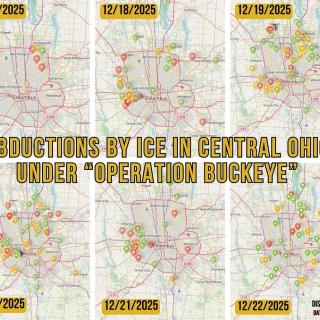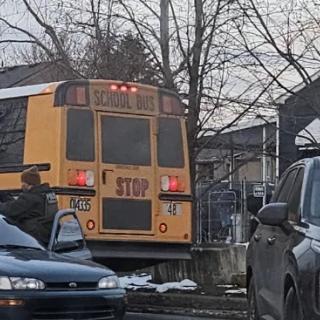Advertisement
The recent killing of Henry Green has spawned protests and a deeper look into the practices and tactics of the Columbus Police. Witnesses stated that there appeared to be no reason for the two officers to shoot Green, who had no criminal record. Police claimed Green brandished a gun. The Franklin County Coroner said Green was shot seven times.
The question of whether the Columbus Police Department disproportionately targets Blacks for violence is best answered with direct evidence, including statistics. A new “police accountability tool” created by the website Mappingpoliceviolence.org is useful in this debate.
Mappingpoliceviolence has studied police violence throughout the nation from January 2013 to June 2016. The group’s focus is on the police forces in the 100 largest cities in the country, where 28 percent of all people are killed by police. The Black population of these major cities is 21 percent but Blacks comprise 39 percent of all people killed by police.
A more telling statistic found that 51 percent of all unarmed people killed by police are Black. This translates into the fact that unarmed Black people are killed at a rate four times higher than unarmed whites.
Another interesting finding by Mappingpoliceviolence is that “rates of violent crime in cities did not make it any more or less likely for police departments to kill people.” For example, the police in Buffalo, New York killed nobody during the three years 2013-16 despite having a high rate of crime.
A key question is how the Columbus police compare and contrast with other national cities and cities in Ohio. In the United States, police homicide rates average 25.2 Blacks killed for every 100,000 Black people. This is double the national average of 12.19 white people killed. The Columbus police rated 16thout of 100 largest cities nationally, with the highest rate in the state of Ohio at 82.7 per 100,000 Blacks.
Contrast this with Cincinnati in the same period which had a rate of 45.3 killings per 100,000 Black people. Cleveland had an even lower rate at 28.8 killed per 100,000 Black people. Toledo rated lowest with only 26 deaths by police per 100,000 Black people.
Ohio itself is higher than the national average, at 32.7 killings per 100,000 Black people. Recent news accounts depicted Milwaukee, Wisconsin rocked by a racist police force and riots, however their rate was almost three times lower than Columbus at 30 police killings per 100,000 Black people. Riots also recently afflicted Baltimore, though its rate is significantly lower than Columbus at 53.4 per 100,000 Blacks.
By these measures, the Columbus police are statistically far more likely to shoot and kill Black people than police forces in general. But the numbers could be worse. Columbus police-involved shootings actually dipped in 2014 and that year was the lowest since 2010. The September 4, 2014 Free Press pointed out that in 2011, Columbus police were the second in the nation of the 50 largest cities in per capita police shootings. In 2011, Columbus police killed eight people, in 2012 there were seven, 2013 had seven, and in 2014 there were only four killed.
The Free Press obtained Columbus law enforcement public records suggesting that the rise inpolice shootings appears to be tied, ironically, to the city’s Summer Anti-Violence Initiative.
A memo from Lieutenant Robert Strausbaugh to then police chief James G. Jackson outlined the 2008 Summer Initiative. The mission was straightforward: “Target and reduce violent crime in high-risk neighborhoods identified by crime analysis information and officer input.”
In 2007 Columbus police shot 11 people, killing two. In 2008, using their new data-driven techniques for targeting high-risk communities – that critics call a code word for black neighborhoods – police shot 21 people and killed six people, three times the rate of deaths as the year before.
As part of the program, five unmarked police cars were added to each high-crime zone. Plainclothes police officers would now be posing in the areas as drug dealers or users. The Initiative that ran for 18 weeks cost more than $1.4 million. Its key focus was on drug arrests.
Sergeant Richard Ketcham of Patrol 5 said that “The overall success of the summer…is a direct result of [it] being run at the Patrol level.” Not considered in the evaluation was the long-standing critique by the Black community that the Columbus Police are overwhelmingly white and reside in the suburbs or in adjacent rural counties. Hence, they function as, what the Columbus Guardian once called, an “occupying army.”
Green was killed this June by white plainclothes Columbus police officers Jason Bare and Zachary Rosen, in an unmarked SUV, as part of the Summer Safety Initiative. More disturbing are the circumstances that seem to have put a whole community at risk.
Activist Kujenga Ashe stated, “The day after the shooting, Pastor Dale Snyder, myself and a Linden commissioner went to the area of the shooting on Duxbury and Ontario. Some of the community residents said that the police were out there spraying bullets while children were out there playing and people were outside. There were bullet holes in three houses. The window was shot out of one house where a lady lived with her children. One house has at least five bullet holes in it. There are bullet holes in the house near where his dead body was laying and bullet holes in the sidewalk where apparently they stood over him and shot him some more.”
Green’s mother, Adrienne Hood, told the Free Press she wants to know why they murdered her son. The only response she got from the police was when a detective told her he was surprised her son did not have a record. “I just want the truth,” she said.




